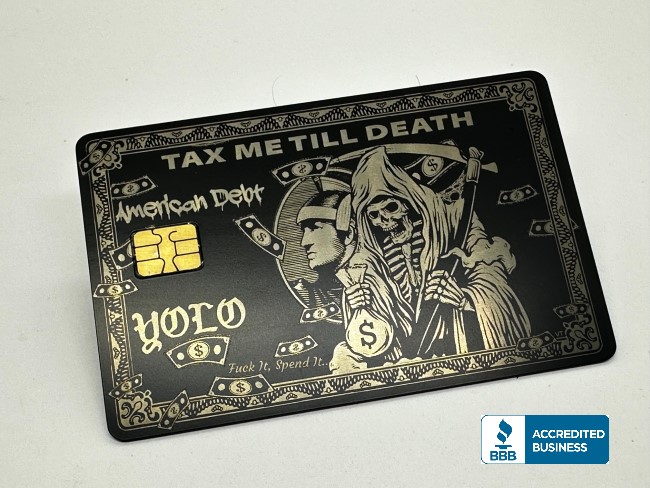Metal Credit Cards vs. Plastic Credit Cards: Which One Should You Choose?
In the world of credit cards, a noticeable shift has occurred as metal credit cards have gained popularity. Traditionally, credit cards were made of plastic, but now “metal” credit cards are making a mark with their premium feel and added benefits. If you’re considering which type of card to choose, understanding the differences between metal and plastic credit cards can help you make an informed decision.
Durability and Aesthetics
One of the standout features of metal credit cards is their durability. Made from materials such as stainless steel, titanium, or other metal alloys, these cards are designed to withstand wear and tear better than their plastic counterparts. They often feature a sleek, polished look that exudes a sense of luxury and prestige. The weight and solid feel of metal credit cards add to their appeal, making them a status symbol for many users.
Plastic credit cards, typically made from polyvinyl chloride (PVC), are lightweight and flexible. While they are durable enough for everyday use, they are more prone to bending, cracking, or wearing out over time compared to metal cards. However, they come in a wide variety of designs and colors, allowing for personalization and expression of style.
Benefits and Perks
Metal credit cards are often associated with premium credit card offerings. These cards typically come with a range of high-end benefits, such as higher credit limits, exclusive rewards programs, travel perks, concierge services, and access to airport lounges. For example, cards like the American Express Platinum or Chase Sapphire Reserve offer extensive travel benefits and significant reward points on purchases. These perks are designed to appeal to high-spending individuals who seek a luxurious lifestyle.
While plastic credit cards might not always match the high-end perks of metal cards, many still offer valuable benefits. Rewards programs, cashback options, and travel benefits can also be found with plastic cards. The key is to choose a card that aligns with your spending habits and financial goals. For everyday users who prioritize practicality over prestige, plastic cards often provide a cost-effective solution with sufficient rewards and benefits.
Custom Metal Credit Cards: An Excellent Alternative
For those looking to stand out even more, custom metal credit cards from companies like Metal-CreditCard.com offer an excellent alternative to commonly issued metal credit cards. These custom cards can be designed to reflect your personal style and preferences, providing a unique blend of luxury and individuality.
Metal-CreditCard.com allows you to transform your existing plastic credit card into a metal one. You can choose from a variety of designs, materials, and finishes to create a card that is truly your own. For instance, a custom card made from brushed stainless steel with your name or company logo engraved can make a powerful statement.

Environmental Impact
The production of metal credit cards involves the use of more resources and energy compared to plastic cards. However, metal cards tend to have a longer lifespan, which could potentially offset the environmental impact over time. Additionally, some issuers offer recycling programs for expired metal cards, ensuring they do not contribute to landfill waste.
Plastic credit cards are less resource-intensive to produce, but their shorter lifespan means they need to be replaced more frequently, contributing to plastic waste. While some issuers also offer recycling programs for plastic cards, the environmental footprint of frequent replacements can be significant.
Cost and Accessibility
The premium nature of metal credit cards often comes with higher annual fees. These fees can range from a few hundred to over a thousand dollars per year, depending on the card and the benefits offered. As a result, metal cards are typically geared toward individuals with higher incomes and excellent credit scores.
Plastic credit cards are generally more accessible to a broader audience. They come in a range of options, from no-annual-fee cards to those with moderate fees, making them suitable for various income levels and credit scores. This accessibility makes plastic cards a practical choice for everyday consumers and those building their credit.
Expert Opinion
Vincent Torres, CEO of Metal-CreditCard.com, emphasizes the growing trend and allure of metal cards: “Metal credit cards represent more than just a payment tool; they symbolize status, security, and a commitment to a premium lifestyle. The added durability and exclusive benefits make them a worthwhile investment for those seeking more from their credit card experience.”
Conclusion: Which Should You Choose?
Choosing between a metal and plastic credit card depends on your lifestyle, spending habits, and financial goals. If you value luxury, exclusive perks, and are willing to pay higher fees, a metal credit card may be the right choice. On the other hand, if you prioritize practicality, lower costs, and accessibility, a plastic credit card could be a better fit.
Ultimately, the best credit card for you is one that aligns with your needs and provides the most value based on your spending patterns. Whether you choose a metal or plastic card, it’s essential to use it responsibly and make the most of the benefits offered.
#metalcreditcards #metaldebitcards

